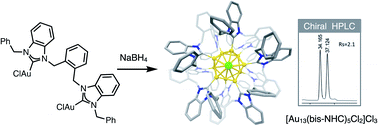Synthesis and enantioseparation of chiral Au13 nanoclusters protected by bis-N-heterocyclic carbene ligands†
Abstract
A series of chiral Au13 nanoclusters were synthesized via the direct reduction of achiral dinuclear Au(I) halide complexes ligated by ortho-xylyl-linked bis-N-heterocyclic carbene (NHC) ligands. A broad range of functional groups are tolerated as wingtip substituents, allowing for the synthesis of a variety of functionalized chiral Au13 nanoclusters. Single crystal X-ray crystallography confirmed the molecular formula to be [Au13(bisNHC)5Cl2]Cl3, with a chiral helical arrangement of the five bidentate NHC ligands around the icosahedral Au13 core. This Au13 nanocluster is highly luminescent, with a quantum yield of 23%. The two enantiomers of the Au13 clusters can be separated by chiral HPLC, and the isolated enantiomers were characterized by circular dichroism spectroscopy. The clusters show remarkable stability, including configurational stability, opening the door to further investigation of the effect of chirality on these clusters.

- This article is part of the themed collections: Sustainable synthesis and catalysis – Chemical Science symposium collection, Chiral Nanomaterials, Materials & Energy in Chemical Science - most popular articles 2021 and 2021 Chemical Science HOT Article Collection


 Please wait while we load your content...
Please wait while we load your content...